Genre: RPG Developer: New World Computing Publisher: Electronic Arts Players: 1 Released: 1991
There are still people out there who wage the age-old war about whether consoles or PCs are the most ideal environment for their gaming passion. Why this still occurs is beyond me, but I can appreciate the history behind such a dispute. There was indeed a time when computers could offer much more than any console could ever hope to, and many genres benefited greatly from the added capabilities. Some still do, like first-person shooters and that icon of PC gaming, the role-playing game.
Yes, PC gamers today are still reaping the incredible benefits of that special thing called the “community mod.” Extra levels and skills, more monsters… it’s all something that keeps console owners looking on with jealous eyes. At least it’s only the user-created content they have to envy, as modern consoles are more than powerful enough to compete with high-end PCs. It wasn’t always so, however, and there was a time when RPG fans had to stare at their PC monitors in awe at the cool titles that seemed to be released almost daily. Virtually none of this goodness came to the gaming systems, but those with a Genesis were pretty lucky to enjoy some of the great Amiga releases of the era.
The thing to remember is that not all of these games are for everyone. Lots of people never gave some of these ports the time they deserved because of the visuals or complex gameplay. King’s Bounty, Faery Tale Adventure, and Might & Magic: Gates to Another World offered deep and compelling gameplay that was well appreciated on the Amiga. Might & Magic, originally the second installment of the series, was especially intimidating to would-be adventurers. The mere sight of its 100+ page instruction manual and massive Electronic Arts cartridge was enough to make you rethink your decision. Those who stuck with it were offered a game that was as massive as it was unforgiving, and the sense of accomplishment felt upon completion was particularly sweet.
What I said about there being a particular brand of RPG fan for this type of game is no exaggeration. Might & Magic is old school in every sense. The story picks up where the original game left off, after King Kalohn the Conjurer defeated the great dragon. As you travel across the world of Cron to find the lost Orb of Power and four elemental talons that hold it (they are all that can restore the land to its former glory), you will find that this is definitely a PC-born RPG. From the text-only battles to the almost complete lack of animation in enemies, this is one game that looked dated upon release. How some people might react to it today is questionable, but as I said earlier, there’s more to this than meets the eye. While M&M might not be able to compete with such other notable Genesis RPGs such as the Phantasy Star or Shining games, it totally blows them away in size and breadth.
Just think for a minute at what New World Computing squeezed into this game. An incredibly large world, two hundred and fifty types of weapons and equipment, almost a hundred spells, over two hundred and fifty different monsters, magic items of all sorts, and more mini quests than you can shake a +1 Rod of Lightning at. Like its modern descendents (think: Morrowind), it’s quite possible to spend tens of hours just roaming around the countryside, hunting for treasure and exploring caves and dungeons, without ever touching the main quest. Be warned though: this is no simple undertaking. In fact, M&M is damned hard. So hard, that I’m having visions from the future of control pads flying and cartridges being yanked from consoles with rapid fury by angry readers. As a PC RPG, M&M goes the distance in offering challenge, so only the stout of heart and patience need apply.
Remember that massive instruction book I mentioned? Dwarfing the hint books Sega included in Phantasy Star II and Sword of Vermilion, it’s a resource you’ll have by your side as you play, rather than neatly tucked away inside the game case. You’ll make great use of it too, as the customization available here was unheard of in a Genesis RPG at the time, and it goes well beyond the typical equipment and spells you normally find. You can quick start with a randomly generated party of six characters or create your own from scratch from eight different classes (Knight, Paladin, Archer, Cleric, Sorcerer, Robber, Barbarians, and Ninjas), as well as add two hired underlings. Each character can be taught different skills that are vital to your quest. For example, someone has to learn the cartographer skill in order to use the auto map, and traveling over mountains is impossible without a mountaineer.
All these skills are necessary for undertaking the over twenty mini quests available for training and upgrading alone. That, in my opinion, is the best thing about M&M. Rather than consisting of just random battles and dungeons, there’s so much more going on with your characters. They train, level up, and even age! I enjoyed this aspect very much, and I spent more than a few hours in the first town alone. It was nice to see an urban center that wasn’t just a place to heal and buy equipment. Along with the tavern and shops, there are training centers, blacksmiths, and even a coliseum! Each one has a life to it that’s lacking in most other console RPGs.
If you’re able to get past the simple presentation, primitive interface, and steep learning curve, there’s one hell of a meaty game to be had here. The box to M&M boasts over a hundred hours of gameplay, and I can honestly say that this is no empty promise. Be ready to die often, but stick with it and you’ll find that this is one adventure worth going on.
SCORE: 6 out of 10

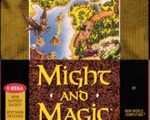
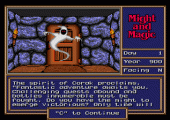
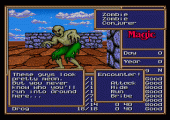
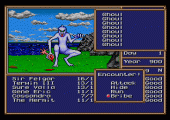
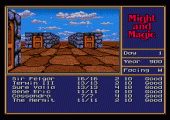
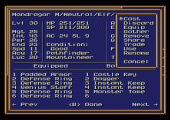
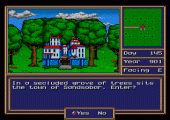
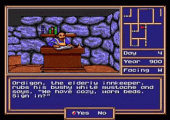
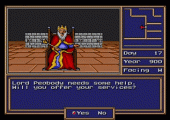
Good review, highlighting all the many positive points and only really mentioning the lack of animation as an issue so find 6/10 a little harsh personally.
I suppose I am a tad biased though as this stands as one of my alltime favourite games 🙂